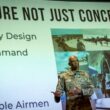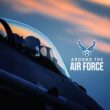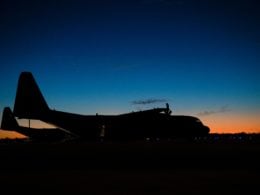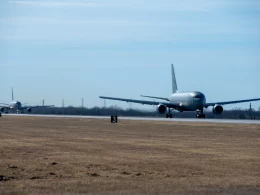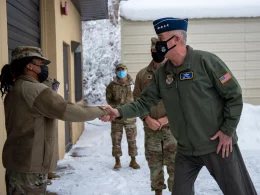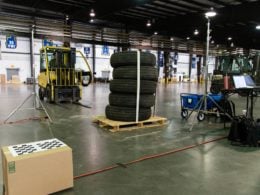FAIRCHILD AIR FORCE BASE, Wash. —
The 92nd Air Refueling Wing tasked personnel and KC-135 Stratotankers to execute a Phase III Lead Wing exercise June 5-9, over multiple locations, in preparation to be lead tanker wing at Air Mobility Command’s capstone exercise, Mobility Guardian 2023.
The Phase III prep exercise took previously tested concepts – aircrew endurance, dynamic air refueling concepts, testing of a variety of the KC-135 mission sets – and tasked crews to sleep on the KC-135 Stratotanker, gaining adequate crew-rest and added the use of commercially available, wearable devices to track real time fatigue/stress on the aircrew.
“We’ve proven that aircrew and KC-135 aircraft can withstand the 72-hour endurance mission,” said Maj. Joseph Brzozowske, 92nd Air Refueling Squadron Director of Operations. “Adding crew rest while on board an aircraft can optimize our flexibility and the use of Smart/Wearable Fatigue Tracking (SWiFT) will give Team Fairchild, and Air Mobility Command, more accurate measures of fatigue to mitigate the negative effects it has on aircrew.”
Fairchild tested basic crews’ ability to complete multiple 24-hour and 16-hour flight duty periods, while optimizing crew rest on the aircraft. Without a waiver, basic crews, comprised of two pilots and one in-flight refueling specialist, are only allowed to operate on a 16-hour flight duty period and are limited to 12-hour flight-duty periods when they are unable to use auto-pilot.
“We have to use every tool at our disposal,” said Col. Chesley Dycus, 92nd ARW commander. “This exercise tested new concepts to accomplish complex missions, ensuring our ability to rapidly project global mobility, and endure throughout geographically dispersed areas with limited communications.”
Fairchild is the lead tanker base for the Defense Innovation Unit’s SWiFT research program. This fatigue mitigation beta testing gave the aircrew customized fatigue curves based on their individual sleep/exercise patterns gathered by smart-wearables. SWiFT can accurately predict times when individual crewmembers will be most at risk to committing an error based on their sleep quality and quantity, circadian rhythm shifts, and other biometric data.
“The aim of the SWiFT program is to reduce fatigue-induced aircrew errors by highlighting vulnerability windows,” according to Maj Nate Mocalis, 92nd Air Refueling Wing Director of Innovation. “Individuals can take active measures to mitigate the effects of fatigue during periods of heightened vulnerability.”
The KC-135 basic crews that flew for a 24-hour duty period were comprised of a three-person crew that had previously tested go-pills. Midway through the 24-hour period, additional aircrew boarded the plane and slept in the bunk areas of the KC-135 during their proper crew rest cycles, with an opportunity for 8 hours of sleep prior to taking the previous crews place in-flight. They were authorized to use any and all anti-fatigue measures to complete the 24-hour duty period. At advanced stages of the crew endurance test, a safety and flight medicine observer were each on board to evaluate fatigue levels and ensure the safety of the crew.
“Every day, we are learning new lessons that we want to apply in combat, so this mission-generation exercise is a chance to test our capabilities at a tempo and scale that approximates combat operations,” said Gen. Mike Minihan, Air Mobility Command commander.
Throughout the 68-hour mission, crews conducted 16-hour flight duty periods to test key Agile Combat Employment concepts for the KC-135 such as: hot pit refueling, concurrent servicing, dynamic re-taskings, and exercising beyond-line of sight communications with command & control authorities.
“Air Mobility Command is the joint force maneuver,” Minihan wrote in ‘Air Mobility Command: The Meaningful Maneuver for Joint Force Victory.’ “the joint force will require the placement of forces to achieve the strategic advantage in conflict, also known as maneuver. AMC will be the meaningful maneuver for the joint force, and we will deliver victory.”
Two aircraft from the 92nd ARW participated in the three-day exercise, performed aerial refueling and associated ACE concepts over Eielson AFB, at McConnell AFB, and MacDill AFB.
“Our decision to be ready, to be integrated, to be agile,” said Minihan
As the world’s Super Tanker Wing, Fairchild continues to refine tactics, techniques and procedures oriented on the Mobility Air Force’s full range of mobility readiness capabilities needed for today’s steady state operations and tomorrow’s high-end fight.
“The crews of Fairchild consistently test to the edge of their limits,” said Col. Chesley Dycus, 92nd ARW commander. “It’s amazing to see – the lessons learned, and data gained during this exercise, and our readiness, will only improve the wing’s ability to support Mobility Guardian in 2023 and demonstrate our unrivaled capabilities in complex environments.”
Testing crew and aircraft endurance combined with locally developed multi-capable airmen concepts like Tanker Drop-in Teams, helps us improve and refine tanker refueling operations in austere and contested environments. All of these concepts combined will be demonstrated when Team Fairchild is lead tanker wing for Air Mobility Command’s capstone exercise Mobility Guardian, in July 2023.





